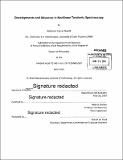Developments and advances in nonlinear terahertz spectroscopy
Author(s)
Brandt, Nathaniel Curran
DownloadFull printable version (20.98Mb)
Other Contributors
Massachusetts Institute of Technology. Department of Chemistry.
Advisor
Keith A. Nelson.
Terms of use
Metadata
Show full item recordAbstract
Nonlinear terahertz (THz) spectroscopy is a rapidly developing field, which is concerned with driving and observing nonlinear material responses in the THz range of the electromagnetic spectrum. In this thesis, I present several advances in nonlinear THz spectroscopy that expand the range of systems in which responses may be driven, the types of responses that may be initiated, and the way in which these responses may be observed. Sufficiently strong THz pulses are generated using the tilted-pulse-front technique, and are collected, focused, and detected using a THz spectrometer specifically designed for maximum peak THz electric field strength and maximum flexibility, allowing for a wide range of experimental geometries to be implemented. Further enhancement in the peak THz electric field strength is obtained through the use of metamaterial structures, which concentrate free-space THz fields in their antenna gaps. Impact ionization was observed in high-resistivity silicon, a material in which no nonlinear THz response had been previously seen, using metamaterial structures to enhance free space THz electric fields. Using three-dimensional metamaterial structures, the THz magnetic field is shown to also be capable of driving ionization processes both in high-resistivity silicon as well as air. Using metamaterial structures with open gaps, the THz electric field is shown to induce breakdown in air at both high and low pressures due to field ionization processes involving the gold metamaterial antennas. Furthermore, THz-driven electromigration of the gold metamaterial antennas is observed. Probing of THz-driven structural changes in both vanadium dioxide and perovskite ferroelectrics is demonstrated using femtosecond Xray pulses from the LCLS facility at the SLAC National Accelerator Laboratory. Finally, ongoing results involving energetic materials, stimulated Raman measurements, and Stark effect measurements are discussed. This work, coupled with the ongoing expansion of nonlinear THz techniques and potential applications demonstrates the continued development of nonlinear THz spectroscopy into a robust and valuable method for investigating fundamental processes in a multitude of systems.
Description
Thesis: Ph. D., Massachusetts Institute of Technology, Department of Chemistry, 2014. Cataloged from PDF version of thesis. Includes bibliographical references.
Date issued
2014Department
Massachusetts Institute of Technology. Department of ChemistryPublisher
Massachusetts Institute of Technology
Keywords
Chemistry.